Sanitation for Pathogens: Contaminated Soil is a Primary Source of Pathogens and Must Be Managed
by Steve Tjosvold
Maintaining good sanitation is one of the most important ways of preventing and managing diseases. Sanitation should be practiced during all phases of production. Practice good sanitation with planting materials, containers, media, irrigation water, benches and growing areas, tools and other equipment, and how workers use and work with these items. Because soil and associated plant debris can be a main source of pathogens, this article will focus on ways to manage contamination from these sources.
Pathogens can be found on the ground and non-sanitized container media, crop debris in soil or potting media, and anything that has contacted the ground, such as equipment, tools, irrigation hoses, and workers’ hands and shoes. Containers should not sit directly on the ground. Many root infecting pathogens can be moved with water from a contaminated pot or area on the surface of the ground and infect roots of a nearby plant (fig. 1).
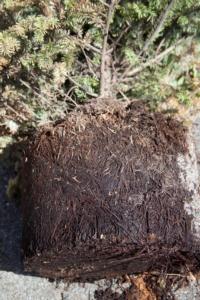
Likewise during a rain storm or, in some cases, during sprinkler irrigation, pathogens can be splashed from the contaminated ground or pot onto nearby plants. Benches or similar structures that support plants above the ground can eliminate or minimize this. In greenhouse structures, concrete floors or other impervious surfaces are ideal for walkways between benches. Floor surfaces should be kept clean of debris, soil, or planting media. After a crop cycle and between crops, benches should be washed clean of plant debris and soil. Benches should be allowed to dry because this can kill sensitive plant pathogens. Metal and plastic benches are ideal because they can be cleaned and sanitized readily (fig. 2).
Fig. 2. Metal benches and concrete flooring are ideal for greenhouse sanitation because they are so easily cleaned and disinfected. Photo: S. Tjosvold. 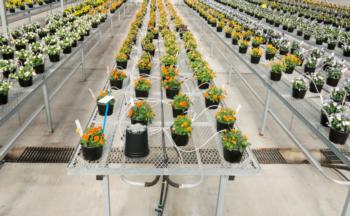
Wooden benches should be regularly painted with copper-containing paints to eliminate fungi or other types of pathogens (fig. 3). Benches can be sprayed with diluted chlorine bleach (0.5 % sodiumhypochlorite solution) or other suitable disinfectant. This should be done after the benches have been thoroughly cleaned of all potting media and plant debris that would inhibit the activity of most disinfectants. Benches should be allowed to dry before they are used again.
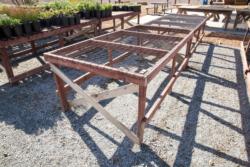
There are many clever ways to raise pots and containers off the ground (fig. 4 and 5). Where benches or other support are not feasible for cost or other reasons, the soil should be covered with gravel and weed cloth.
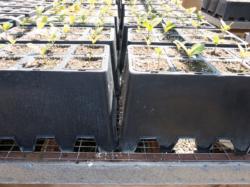
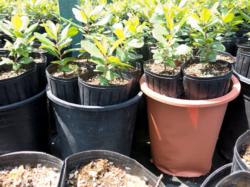
Gravel supports containers above the drainage water; the weed cloth (which also reduces weed germination) helps reduce splash and can be cleaned of soil and plant debris between crops (fig. 6).
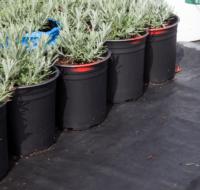
Pots, flats, tools (fig. 7) and irrigation equipment such as piping or emitters can have clinging contaminated soil and plant debris and should never be reused without thoroughly washing them to remove all clinging particles.
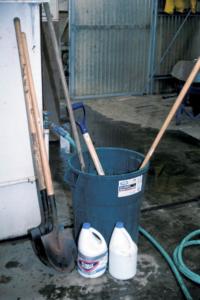
They can then be treated with a disinfectant such as diluted chlorine bleach. The bottom of clean shoes can be sanitized with disinfectants such as quaternary ammonium compounds (fig. 8).
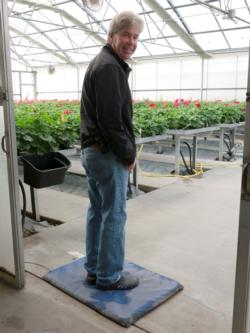
Potting media should not be reused, as the risk of pathogen carryover is too great and not worth the savings in most cases. Even some newly formulated mixes may benefit from steam treatment if the sources of the media are unknown or unreliable. Contact the soil formulator of these products to insure they are free of pathogens. Aerated steam is the most efficient way of sanitizing potting media.
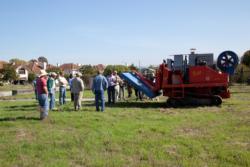
Portable steam generators are available for sale or rent for small batches, and commercial greenhouses may use the steam from boilers used for heating greenhouses (fig. 9 and 10).
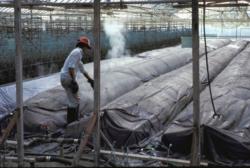
For most situations, aerated steam treatment of 140° to 160°F for 30 minutes will kill the most problematic pathogens while preserving the natural microflora of the growing medium. Store and handle potting media so it does not come in contact with the ground or water runoff. Cover the media when not in use (fig. 11).
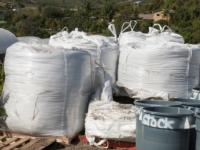
Steve Tjosvold is UC Cooperative Extension Environmental Horticulture Farm Advisor, Santa Cruz and Monterey counties.












